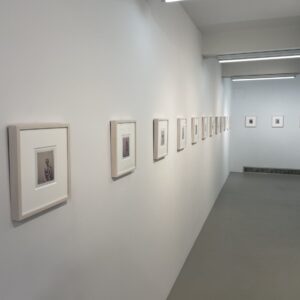JTF (just the facts): A total of 17 color photographs, framed in white and unmatted, and hung against white walls in the small gallery space, in the reception area, and intermingled in the office. All of the works are archival pigment prints, made between 1996 and 2017. Physical sizes range from roughly 20×30 to 59×88 inches, and the prints are available in editions of 1, 3, 5, or 10, based on size. (Installation shots below.)
A monograph of this body of work is forthcoming from Nazraeli Press (here).
Comments/Context: The only recognizable human in Todd Hido’s new show stands facing into enveloping blackness. The young woman has hair with a hint of purple, its mass tied in a gently messy twist of braiding, and her arms are pulled behind her, perhaps in a shoulder-opening stretch or somehow bound. As she faces the darkness that stands before her, hidden restraints seem to hold her back, offering us a sense of heading into the void without all of our defenses.
Hido has been exploring the contours of photographic melancholy for more than a decade now, from lonely lit windows pregnant with neo-noir mystery to misty wet glass landscapes where blur softens the open roads, and Bright Black World finds him falling deeper into this well. In his newest pictures, he has ventured out beyond the borders of the United States, repeatedly traveling to the lands of Northern Europe, where winter grips with tighter fingers and the landscape of frozen tundra feels apocalyptic when the darkness comes. Whether he brought his darkening aesthetic mood with him or simply found it there in the wilds of the north country, his new pictures edge toward persistent bleakness, even when pastel skies float overhead.
Many of Hido’s photographs linger at the threshold where depressing grimness topples over into unexpected beauty. Dense thickets block our view of seething skies, smoke rises from scrub forests, and the horizon is dropped extra low to allow the swirling dark clouds in the sky to tower with more cheerless majesty. Choking haze is a common visual theme, the soup of brownish yellow mist blotting out any sense of depth, with only a few evergreen silhouettes, a flock of deer, a vague farmhouse, and the pinprick of the sun piercing through the thick veil.
In past bodies of work, Hido repeatedly used roads falling away into the narrowing of distant perspective, and that motif is revived here with the somber mood amplified. Now the roads lead off toward foreboding clouds, into murky light, and even toward an industrial hellscape of black forms, the rain on the car window giving the compositions a painterly effect. The largest of the prints in the show uses a road to bend off into a bright snowscape that leads down to the roiling sea, the barren unforgiving landscape finding a touch of grace in the biting severity of winter. In each case, the empty road reminds us of our exposed vulnerability, the stark loneliness heightened amid the dim surroundings.
When Hido brings a touch of humanity into these landscapes, he inevitably does it with the presence of a lone light, like a lighthouse standing as a beacon for lost travelers. Flares of orange light spark up out of the cloud-dampened twilight, a single roadside light splashing color across the otherwise muted palette of the landscape. The neon red of a motel sign achieves the same purpose, as does a solitary lamppost on a rocky point and the lit crosses on a snowy moonscape (much like the fleeting spotlight effect in Ansel Adams’ Moonrise over Hernandez, NM). Each one provides the same oblique compositional function – to offer glimmers of warmth in the otherwise cold (and sometimes rainy) night.
A clouded view of the stars in the night sky feels like a fitting summing up of this project – the scale of the universe is vast and imposing, our presence a mere spot against its immensity, especially when the clouds block our ability to see clearly. But those sparkles in the sky also light the darkness just a bit, breaking up the mournfulness that might normally come from recognizing such obvious insignificance.
Hido deliberately straddles dividing lines with these photographs, pushing back and forth between despair and hope. These edges and complexities aren’t always comfortable, and Hido’s mood leans toward darkness rather than light in most cases. But when that charge hits home, it feels more authentic that some of the more mannered cinematic studies of his earlier work. As our own national mood darkens, pictures like these seem to match the pathways of our troubled minds.
Collector’s POV: The works in this show are priced between $4000 and $34000, based on size. Hido’s work has become intermittently available in the secondary markets in the past few years; recent prices have ranged from roughly $2000 to $37000.
















